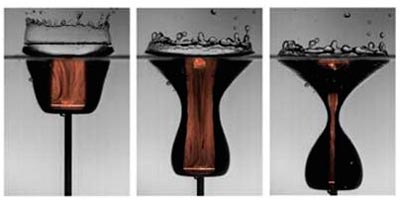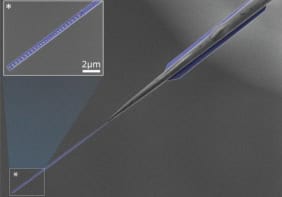
There is something satisfying about the plonk and splash of a stone falling through the smooth surface of a pond. But now this seemingly ordinary, albeit pleasing, phenomenon appears to be anything but mundane. A sinking stone, it turns out, can create a supersonic jet of air.
When a stone plunges into water, a cylindrical sheet of water called the “crown splash” is sent up into the air. As the stone begins to sink, it pulls a cylindrical cavity of air down with it. The surrounding water then pinches middle of the cavity to create an hourglass shape. The cavity begins to collapse and the upward rush of air causes the spectacular finale – a jet of water that shoots high up above the surface of the pond.
Detlef Lohse and colleagues at the University of Twente and the University of Valencia have now shown that this final rush of air moves faster than the speed of sound.
Cloud of smoke
The team watched this happen by pulling a 40 mm diameter disc below the surface of a water tank that was covered in a cloud of smoke. The smoke was sucked into the air cavity, allowing the physicists to study its shape using a high-speed camera that can also track the motion of individual smoke particles.
Lohse’s team found that the shape of the hourglass constriction resembles a “de Laval nozzle”, which is used in supersonic jet and rocket engines. The team was able to measure the diameter of the nozzle and found that it shrinks rapidly as time progresses, which boosts the speed of the escaping air.
By tracking the smoke particles, the team was able to measure air speed as a function of nozzle diameter up to speeds of about 10 m/s – much less than 343 m/s, which is the speed of sound in air. Undeterred, the team was able to use this data along with numerical simulations to predict the speed of the air for much smaller nozzle diameters. They concluded that the air could accelerate to beyond the speed of sound when the diameter of the neck shrinks to about 2% of its original size.
Shockwave spotted
The team also saw a shock wave develop above the nozzle, which they say is further evidence for supersonic flow. It creates two jets of water – one that flows downward and the other upward beyond the surface. The latter often exceeds the height from which the splashing object is dropped.
Many of these effects can be seen without smoke or cameras – so find yourself a stone and pond, and break the speed of sound.
The work is described in Physical Review Letters.



